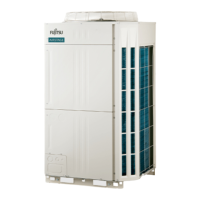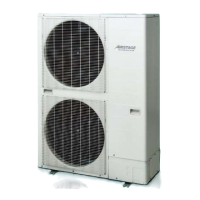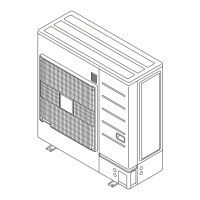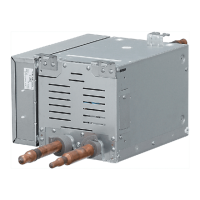En-23
7. 8. Resistance measurement of transmission cable
(Measure with breaker OFF)
CAUTION
Do not turn on the power if the resistance between the terminals of the transmis-
sion cable is abnormal. Otherwise, the circuit board may be damaged.
Measure the resistance between 2 terminals of a transmission cable.
(1) Transmission cable connecting indoor units, outdoor units, and signal
amplifi ers
Measure the resistance of the signal amplifi er terminal and the terminal of the
indoor and outdoor units connected farthest away from the device where terminal
resistor is measured.
A value from the table is displayed, depending on the distance from the signal
amplifi er and the device where the terminal resistor is set.
This value is an estimate.
(2) Transmission cable connecting outdoor units in a refrigerant system
The resistance between the terminals of the transmission cable is 45 to 60Ω.
This value is an estimate.
Distance from terminal resistor [ft (m)]
0 ~328
(0 ~100)
~656
(~200)
~984
(~300)
~1,312
(~400)
~1,640
(~500)
Approximate resistance (Ω)
0 ~ 50
A short circuit somewhere or 2 or more terminal resistors are con-
nected
50
60
70
80
90
100
110
120
130
140
150
160
170
180
190 ~ Faulty contact or wiring length over 1,640 ft (500 mm)
1K ~∞ Faulty contact, open circuit, or no termination resistor
8. PIPE INSTALLATION II
Fig. A Connection system
A) In case of connected 1 outdoor unit
Outdoor unit
Pressure gauge
Vacuum
pump
Scale
Pressure regulating
valve
Nitrogen
RB unit
Indoor unit
B) In case of connected many outdoor units
Pressure regulating valve
Pressure gauge
Outdoor unit Outdoor unit
Nitrogen
Scale
Vacuum
pump
RB unit
Indoor unit
Fig. B
Charging cap
Valve
Cap
Close
Hexagon
wrench
Close
Open
Open
Spindle
Table. A
Valve type Spindle Cap Charging cap
Liquid
6.6 to 8.9 lbf·ft
(9.0 to 12.0 N·m)
14.8 to 17.7 lbf·ft
(20.0 to 24.0 N·m)
9.2 to 11.8 lbf·ft
(12.5 to 16.0 N·m)
Suction gas
Discharge gas
19.9 to 24.4 lbf·ft
(27.0 to 33.0 N·m)
18.5 to 22.1 lbf·ft
(25.0 to 30.0 N·m)
9.2 to 11.8 lbf·ft
(12.5 to 16.0 N·m)
8. 1. Sealing test
CAUTION
• Use only nitrogen gas.
Never use refrigerant gas, oxygen, in fl ammable gas or poisonous gas to pressur-
ize the system. (If oxygen is used. There is danger of an explosion.)
• Do not shock during sealing test.
It can rupture the pipes and cause serious injury.
• Do not turn on the power unless all operations are complete.
• Do not block the walls and the ceiling until the sealing test and charging of the
refrigerant gas have been completed.
After connecting the pipes, perform a sealing test.
Recheck that the spindle of the 3-way valve are closed before performing a sealing
test. (Fig. B)
Pour nitrogen gas through both the liquid pipe and the gas pipe.
Pressurize nitrogen gas to 609 psi (4.2 MPa) to perform the sealing test.
Check all fl are connection areas and brazed areas.
Then, check that the pressure has not decreased.
Compare the pressures after pressurizing and letting it stand for 24 hours, and check
that the pressure did not decreased.
* When the outdoor temperature changes 9 degrees F (5 degrees C), the test
pressure changes 7.25 psi (0.05 MPa).
If the pressure has dropped, the pipe joints may be leaking.
If a leakage is found, immediately repair it and perform a sealing test again.
* Decrease the pressure of nitrogen gas before brazing
After completing the sealing test, release the nitrogen gas from both valves.
Release the nitrogen gas slowly.
8. 2. Vacuum process
CAUTION
Do not turn on the power unless all operations are complete.
If the system is not evacuated properly, its performance will drop.
• If moisture enter the piping, follow below. (i.e., if doing work during the rainy season,
if the actual work takes long enough that condensation may form on the inside of the
pipes, if rain might enter the pipes during work, etc.)
• After operating the vacuum pump for 2 hours, pressurize to 7.25 psi (0.05 MPa) (i.e.,
vacuum breakdown) with nitrogen gas, then depressurize down to 500 microns
(-100.7kPa) for an hour using the vacuum pump (vacuum process).
• If the pressure does not reach 500 microns (-100.7kPa) even after depressurizing
for at least 2 hours, repeat the vacuum breakdown - vacuum process.
After vacuum process, maintain the vacuum for an hour and make sure the pressure
does not rise by monitoring with a vacuum gauge.
Evacuation procedure
1) Remove the caps of the gas pipe and liquid pipe and check that the valves are
closed.
2) Remove the charging cap.
3) Connect a vacuum pump and a pressure gauge to a charging hose and connect
it to the charging port.
4) Activate the vacuum pump and vacuum the indoor unit and connection piping
until the pressure gauge becomes 500 microns (-100.7kPa).
Evacuate from both the gas pipe and the liquid pipe.
5) Continue evacuating the system for 1 hour after the pressure gauge reads
500 microns (-100.7kPa).
6) Remove the charging hose and reinstall the charging cap.
9378945159-04_IM.indb 239378945159-04_IM.indb 23 2015/12/1 10:50:582015/12/1 10:50:58

